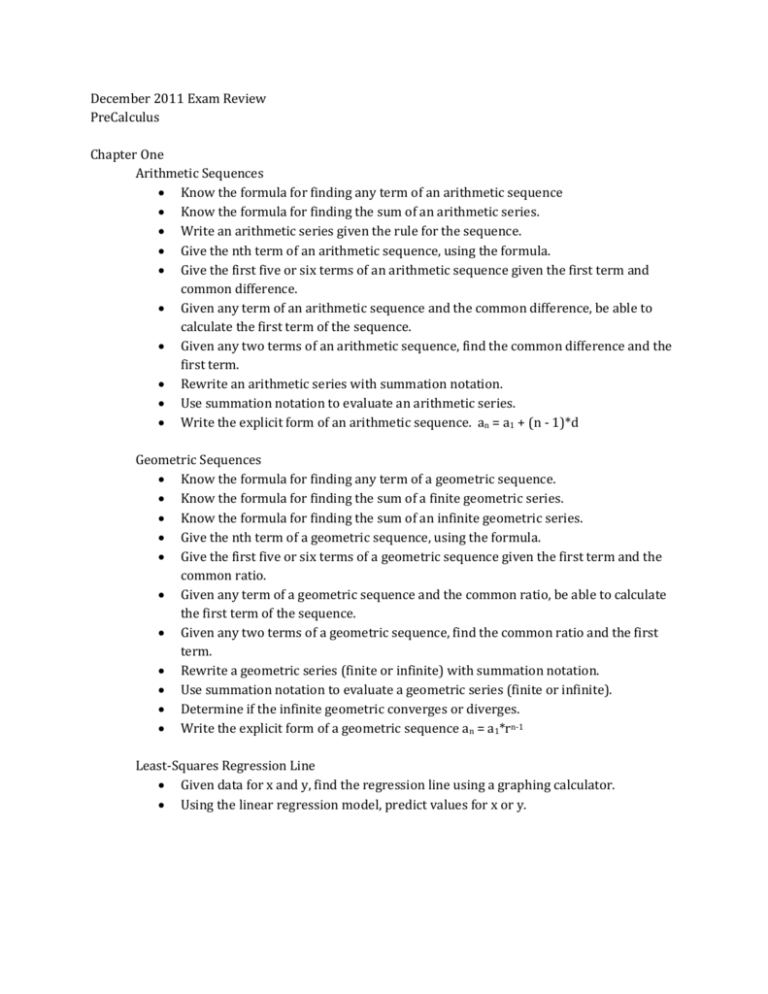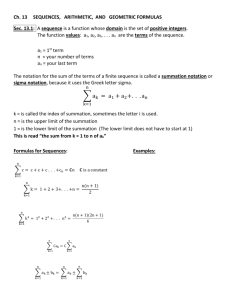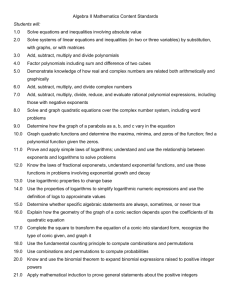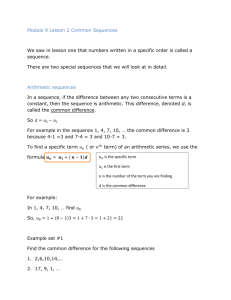December 2011 Exam Review PreCalculus Chapter One Arithmetic
advertisement

December 2011 Exam Review PreCalculus Chapter One Arithmetic Sequences Know the formula for finding any term of an arithmetic sequence Know the formula for finding the sum of an arithmetic series. Write an arithmetic series given the rule for the sequence. Give the nth term of an arithmetic sequence, using the formula. Give the first five or six terms of an arithmetic sequence given the first term and common difference. Given any term of an arithmetic sequence and the common difference, be able to calculate the first term of the sequence. Given any two terms of an arithmetic sequence, find the common difference and the first term. Rewrite an arithmetic series with summation notation. Use summation notation to evaluate an arithmetic series. Write the explicit form of an arithmetic sequence. an = a1 + (n - 1)*d Geometric Sequences Know the formula for finding any term of a geometric sequence. Know the formula for finding the sum of a finite geometric series. Know the formula for finding the sum of an infinite geometric series. Give the nth term of a geometric sequence, using the formula. Give the first five or six terms of a geometric sequence given the first term and the common ratio. Given any term of a geometric sequence and the common ratio, be able to calculate the first term of the sequence. Given any two terms of a geometric sequence, find the common ratio and the first term. Rewrite a geometric series (finite or infinite) with summation notation. Use summation notation to evaluate a geometric series (finite or infinite). Determine if the infinite geometric converges or diverges. Write the explicit form of a geometric sequence an = a1*rn-1 Least-Squares Regression Line Given data for x and y, find the regression line using a graphing calculator. Using the linear regression model, predict values for x or y. Chapter Two Polynomials Given a polynomial determine the degree, the leading coefficient, possible number of zeros, possible number of turning points (extrema), and end behavior without a calculator. Using a calculator, determine the x-intercepts (zeros), y-intercepts, maximum or minimum (extrema), and end behavior of a polynomial. Factor polynomials to determine the zeros the function. Using the Rational Root Theorem, determine the possible rational roots. Using the Factor Theorem or synthetic division, find the real zeros. Using the Descartes’ Rule of Signs, determine the number of positive and negative roots. Given the degree and zeros (real and complex), write a polynomial of lowest degree with real coefficients. Rewrite a polynomial function as the product of complex factors and find the zeros. Rational Functions Determine horizontal, vertical, and slant asymptotes, if any, of a rational function. Give the domain and range of a polynomial function. 1 Identify the parent functions of y = x, y = x2, y = x3, y = 𝑥, y = ІxІ, and y = √𝑥. Determine how the graph of a function changes when a constant is added (or subtracted) to x or added (or subtracted) to y. Determine how the graph of a function changes when a constant is multiplied by x or y. Determine whether undefined values for the rational function are vertical asymptotes or holes on the graph. Create a rational function from its asymptotes. Exponential Functions Write an exponential function for growth or decay problems. Determine the balance of an account with compound interest.








